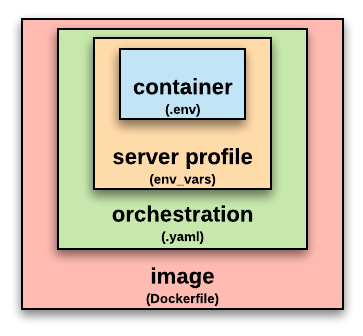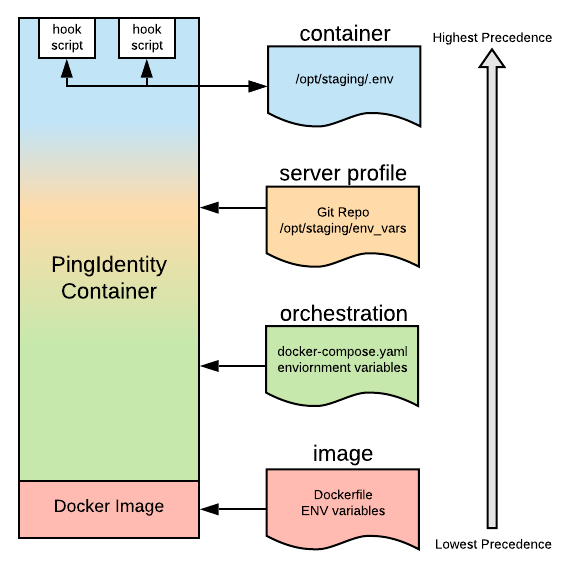Variables and scope ¶
Variables provide a way to store and reuse values with our Docker containers which are ultimately used by our Docker image hooks to customize configurations.
It's important to understand:
- The different levels at which you can set variables
- How you should use variables
- Where you should set and use variables
The following diagram shows the different scopes in which variables can be set and applied.

Assume that you are viewing this diagram as a pyramid with the container at the top. The order of precedence for variables is top-down. Generally, you set variables having an orchestration scope.
Image scope ¶
Variables having an image scope are assigned using the values set for the Docker image (for example, from Dockerfiles). These variables are often set as defaults, allowing scopes with a higher level of precedence to override them.
To see the default environment variables available with any Docker image, enter:
docker run pingidentity/<product-image>:<tag> env | sort
Where <product-image> is the name of one of our products, and <tag> is the release tag (such as edge).
For the environment variables available for all products (PingBase) or individual products, see the Docker Images Reference.
Orchestration scope ¶
Variables having orchestration scope are assigned at the orchestration layer. Typically, these environment variables are set using Docker commands, Docker Compose or Helm values. For example:
-
Using
docker runwith--env:docker run --env SCOPE=env \ pingidentity/pingdirectory:edge env | sort -
Using
docker runwith--env-file:echo "SCOPE=env-file" > /tmp/scope.properties docker run --env-file /tmp/scope.properties \ pingidentity/pingdirectory:edge env | sort -
Using Docker Compose (docker-compose.yaml):
environment: - SCOPE=compose env_file: - /tmp/scope.properties -
Using Kubernetes:
env: - name: SCOPE value: kubernetes -
Using Helm variables:
global: envs: PING_IDENTITY_ACCEPT_EULA: "YES" PING_IDENTITY_PASSWORD: "2Federate" ...
Server profile scope ¶
Variables having server profile scope are supplied using property files in the server-profile repository. You need to be careful setting variables at this level because the settings can override variables already having an image or orchestration scope value set.
You can use the following masthead in your env_vars files to provide examples of setting variables and how they might override variables having a scope with a lower level of precedence. It will also suppress a warning when processing the env_vars file:
# .suppress-container-warning
#
# NOTICE: Settings in this file will override values set at the
# image or orchestration layers of the container. Examples
# include variables that are specific to this server profile.
#
# Options include:
#
# ALWAYS OVERRIDE the value in the container
# NAME=VAL
#
# SET TO DEFAULT VALUE if not already set
# export NAME=${NAME:=myDefaultValue} # Sets to string of "myDefaultValue"
# export NAME=${NAME:-OTHER_VAR} # Sets ot value of OTHER_VAR variable
#
Container scope ¶
Variables having a container scope are assigned in the hook scripts and will overwrite variables that are set elsewhere. Variables that need to be passed to other hook scripts must be appended to the file assigned to ${CONTAINER_ENV}, (which defaults to /opt/staging/.env). This file is sourced by every hook script.
Scoping example ¶
